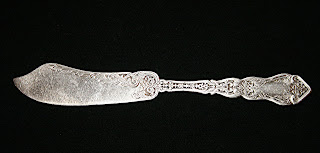This is a set of four Fruit Knives. They are quite old and are monogrammed. Fruit knives are six to seven inches long and are used along with fruit spoons. They are used for cutting and peeling fruits served at the dinner table.
Here we have a large serving spoon or table spoon. The smaller spoon is a sugar spoon.
These four ladles are different sizes and have a variety of uses. The first from the left is a large gravy ladle. This is the most common of ladles. Large gravy ladles are six to eight inches in size. The next ladle to the right is a smaller gravy ladle. The size of the gravy ladle should be determined by the size of bowl or gravy boat you use for gravy. The third from the left ladle is a cream sauce ladle. Sauces like Bearnaise or Hollandaise call for this size. The last piece is a mustard ladle. This is a very old piece of flatware and not used so much today. This is a particularly attractive piece and there is a closer view in the next photograph.
This cute little spoon is a jelly server. They are six to seven inches long and are used for scooping and serving jelly and jam. Sometimes they come with a jelly bowl sitting in a rack. The jelly spoon hangs in the rack above the bowl.
This odd looking knife is a cheese pick. The blade is used for cutting through smaller blocks of cheese while the teeth at the end are used to pick up the small slices of cheese. The cheese pick is longer than a butter knife measuring eight to nine inches.
This is a Pierced Bonbon Spoon from the 1930's. The bonbon spoon is pretty easy to figure out....it is used for serving bonbons. The term "bonbon" dates back to 17th century France. It refers to candies that were used as centerpieces and eaten. "Bon" in French means "good". There are pierced bonbon spoons and solid bonbon spoons. They have the same use. Many examples are quite decorative as is this spoon.
This is a sterling Candle Snuffer. It is used for snuffing out burning candles. This one belonged to my mother and has seen many years of use.
These Iced Beverage Spoons have the look of vermeil. Vermeil is made by applying mercury and gold. This is done today by an electrolytic process. I received this set of spoons from my father one Christmas for my hope chest.
These are the largest of the spoons in my Salt Spoon collection. I was given an entire collection of Salt Cellars and a couple of Salt Spoons. Over the years, I have added to the spoons. These three are about four to four and a half inches in length, which is on the longer side for salt spoons. These are sterling.
On the other end of the spectrum, these are some of the smallest salt spoons I own. The two spoons with shell shaped bowls are not more than two inches long. The first on the left is a modern 1960's pattern and the two on the right end date back to the turn of the 20th century. These five spoons are also sterling.
And finally these three Salt Spoons are to my sterling pattern. They have gold bowls and are about three and a half inches in length. I use Salt Cellars with Salt Spoons at most dinners I serve in my dining room. It is something my mother did and as a child I loved little bowls and the tiny spoons. My daughter was the same way growing up and it is still her job to go to the display cabinet where the "Salts" are kept and select one for each person at the table. I use tiny silver or crystal pepper shakers beside the Salt Cellar.
This is a Baby Fork and Baby Spoon. The fork dates to the 1940'd and the spoon to the 1930's. They are both sterling and well used.
This is another Baby Fork and Spoon set. It is sterling and they measure four to five inches. This set dates from the 1940's.

















































